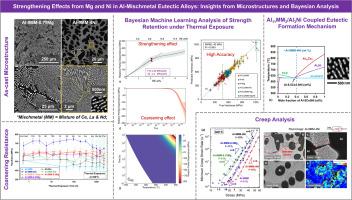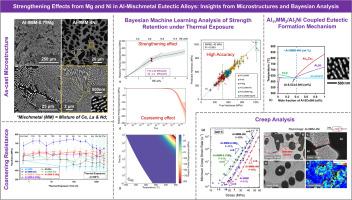Strengthening effects from Mg and Ni in Al-mischmetal eutectic alloys: Insights from microstructures and Bayesian analysis
IF 8.3
1区 材料科学
Q1 MATERIALS SCIENCE, MULTIDISCIPLINARY
引用次数: 0
Abstract
This study investigates, both experimentally and via machine-learning modeling, the strengthening mechanisms and effects of Mg and Ni additions to Al-MM (mischmetal, a sustainable Ce+La+Nd mixture to replace Ce) alloys, aiming to develop creep- and coarsening-resistant Al-MM-Mg-Ni alloys with a focus on twin eutectic co-solidification microstructures. Based on near-eutectic Al-9MM (wt%) alloy, the Mg and Ni additions introduce solid-solution and eutectic strengthening, respectively. Ternary hypo-eutectic Al-9MM-0.25/0.5/0.75Mg variants improve hardness up to 592 MPa. Ternary Al-9MM-2/4Ni display hypo-eutectic microstructures. Al-9MM-2Ni shows separated growth of Al11MM3 and Al3Ni eutectic phases, while Al-9MM-4Ni features finely intertwined Al11MM3-Al3Ni fibers from co-solidification. The hyper-eutectic Al-9MM-5Ni contains primary Al3Ni particles alongside the intertwined fibers, raising the hardness to 739 MPa. Finally, quaternary Al-9MM-0.5/0.75Mg-4/4.5Ni alloys maintain hypo-eutectic microstructures with a significant increase of hardness to 929 MPa. The series Al-9MM, Al-9MM-0.75Mg, Al-9MM-4Ni, and Al-9MM-4.5Ni-0.75Mg exhibits increasing tensile yield strengths of 70, 83, 88, and 105 MPa, with decreasing ductility of 12.0, 5.8, 2.0, and 0.8 %. All Al-9MM-Mg-Ni alloys exhibit excellent hardness retention and coarsening resistance after thermal exposure at 300 or 350°C for up to 11 weeks. A machine-learning model accurately predicts the alloy's hardness evolution under thermal exposure. Feature analysis quantitively shows the strengthening impact of MM, Ni, and Mg addition and demonstrate enhanced strengthening retention, under thermal exposure, of Al11MM3 over Al3Ni, alongside the beneficial effects of Mg homogenization. At 300 °C, Al-9MM-Mg-Ni alloys demonstrate higher creep resistance than most precipitation-strengthened Al-Sc-Zr-based alloys and solid-solution-strengthened Al-Mg alloys, with Al-9MM-4Ni as the best performer.


铝-双金属共晶合金中镁和镍的强化效应:微结构和贝叶斯分析的启示
本研究通过实验和机器学习建模,研究了在 Al-MM(mischmetal,一种替代 Ce 的可持续 Ce+La+Nd 混合物)合金中添加镁和镍的强化机制和效果,旨在开发抗蠕变和抗粗化的 Al-MM-镁镍合金,重点研究孪晶共熔微观结构。在近共晶 Al-9MM (wt%) 合金的基础上,添加的镁和镍分别引入了固溶和共晶强化。三元低共晶 Al-9MM-0.25/0.5/0.75Mg 变体可将硬度提高到 592 兆帕。三元 Al-9MM-2/4Ni 显示出低共晶微观结构。Al-9MM-2Ni 显示出 Al11MM3 和 Al3Ni 共晶相的分离生长,而 Al-9MM-4Ni 则显示出共凝固产生的 Al11MM3-Al3Ni 纤维的精细交织。超共晶 Al-9MM-5Ni 在纤维交织的同时还含有原生 Al3Ni 颗粒,从而将硬度提高到 739 兆帕。最后,四元Al-9MM-0.5/0.75Mg-4/4.5Ni合金保持了低共晶微结构,硬度显著提高至929兆帕。Al-9MM、Al-9MM-0.75Mg、Al-9MM-4Ni 和 Al-9MM-4.5Ni-0.75Mg 系列的拉伸屈服强度分别为 70、83、88 和 105 兆帕,延展性分别为 12、5.6、2.0 和 0.8 %。所有铝-9MM-镁-镍合金在 300 或 350°C 高温下暴露长达 11 周后,都表现出优异的硬度保持性和抗粗化性。机器学习模型可准确预测合金在热暴露条件下的硬度变化。特征分析定量地显示了添加 MM、Ni 和 Mg 对强化的影响,并证明在热暴露条件下,Al11MM3 比 Al3Ni 具有更强的强化保持力,同时 Mg 均质化也产生了有益的影响。300 °C 时,Al-9MM-镁-镍合金的抗蠕变性高于大多数沉淀强化的 Al-Sc-Zr 基合金和固溶强化的 Al-Mg 合金,其中 Al-9MM-4Ni 的性能最佳。
本文章由计算机程序翻译,如有差异,请以英文原文为准。
求助全文
约1分钟内获得全文
求助全文
来源期刊

Acta Materialia
工程技术-材料科学:综合
CiteScore
16.10
自引率
8.50%
发文量
801
审稿时长
53 days
期刊介绍:
Acta Materialia serves as a platform for publishing full-length, original papers and commissioned overviews that contribute to a profound understanding of the correlation between the processing, structure, and properties of inorganic materials. The journal seeks papers with high impact potential or those that significantly propel the field forward. The scope includes the atomic and molecular arrangements, chemical and electronic structures, and microstructure of materials, focusing on their mechanical or functional behavior across all length scales, including nanostructures.
 求助内容:
求助内容: 应助结果提醒方式:
应助结果提醒方式:


